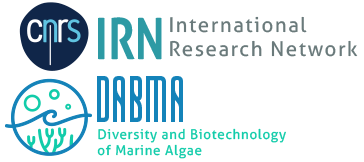Comparative transcriptome profiling of Gracilariopsis tenuifrons (Gracilariales, Rhodophyta) in response to temperature-stressed
Andre V. F. Faria and Estela M. Plastino (University of São Paulo). Olivier Godfroy and J. Mark Cock (Station Biologique de Roscoff)

Gracilariopsis tenuifrons (C.J. Bird and E.C. Oliveira) Fredericq & Hommersand is an agarophyte of economic importance widely distributed along the Brazilian coast. Due to its wide distribution, populations of Gp. tenuifrons are subject to different environmental factors, such as temperature. According to IPCC forecasts, the SST may increase by 1.5-2°C until 2050, and our knowledge is incipient to know how tropical seaweeds can manage this change. In this study, our hypotheses are: i) by thermoregulation process, it is expected that individuals of Gp. tenuifrons, when cultivated at different temperatures, 25 and 33°C, will show different gene expressions; and ii) individuals cultivated in high temperature (33°C) may express genes related to prevent heat damage, and maintenance their physiological performance. To test these hypotheses in the current project, our goals are to evaluate RNA-seq gene expression in individuals from São Paulo State (range-edge distribution) grown at different temperatures (25 and 33°C). To achieve the objectives and answer these hypotheses, the function of the differentially expressed genes (DEG) regulated up and down is being investigated and enrichment of Gene Ontology (GO) categories is being conducted using GOseq. The performance of this study should enable the genetic characterization of Gp. tenuifrons and will be important for the recognition of genes related to thermal stress and phenotypic plasticity.
How gamete encounters is maximized in Gracilaria?
Myriam Valero and Christophe Destombe (CNRS, Université de Paris VI, Roscoff, IRL EBEA 3614), Marie-Laure Guillemin (UACH, Universitad Austral de Chile, Valdivia, UMI IRL 3614), Emma Lavaut (CNRS, Université de Paris VI, Roscoff, IRL EBEA 3614 and UACH, Universitad Austral de Chile, Valdivia, UMI IRL 3614)
In the majority of sexual organisms, male gametes are flagellated. However, there are some rare taxa distributed in the tree of life in which male gametes do not have flagella. In these groups, it is important to understand how gametes encounter is maximized since the sperm does not have the capacity to move actively or to change direction to fertilize the female gametes nearby. The aim of this project is to address this fundamental question of the gamete encounter in the European G. gracilis and the Chilean G. chilensis species by using the new molecular tools available today in these organisms, in order to study the evolutionary strategies that have been implemented to maximize the probabilities of fertilization. In particular, this project proposes to test the relative importance of the different mechanisms potentially involved in fertilization: (1) increasing the abundance of male gametes (synchronization of release, density); (2) biotic pollinator-type interactions; (3) polymorphism in the expression of the sexual phenotype that generates bisexual variants resulting in a physical proximity between spermaties and female gametes.
Abundance of male gametes will be measured by direct counting under a microscope, Q-PCR and nephelometry. Biotic pollinator-type interactions will be tested by controlled experiment in the laboratory. Variants of the life cycle sampled in the field will be characterized for their ploidy and their sex using flowcytometry, genotyping for nuclear and sex markers. The fertility of variants will be tested by controlled crosses with male and female “regular” gametophytes in the lab.

Genomic scale metabolic modelling of a kelp holobiont
Sylvain Faugeron (PUC), Carolina Camus (U. Lagos), Simon Dittami and Phlippe Potin (UMR8227), Natalia Jimenez and Ziomara Gerdtzen (U. Chile)
The general goal of our project is to improve our understanding of the expression of traits of interest in the study of adaptive divergence and for resilient aquaculture of the giant kelp Macrocystis pyrifera. Its large geographic range rises questions about its capacity to cope with different environmental conditions. Population genetic studies, breeding experiments and assessment of local adaptation suggest subtle adaptive divergence along the coast of Peru-Chile. In parallel, breeding experiments have shown the feasibility to manipulate traits for aquaculture improvement. More recently, the role of epibacterial communities in nitrogen metabolism and growth rate have been evidenced (Flores et al. 2021), suggesting the worldwide success of the giant kelp could be explained, at least in part, by the metabolic interactions between the kelp and its associated bacteria (see review by Dittami et al 2021 for examples of other seaweeds).
In Chile, a 6-year program called Marine Agronomy of Seaweed Holobionts (MASH) has just launched, led by C. Camus and S. Faugeron, with the participation of P. Potin as senior researcher. One of the three main research lines focuses on disentangling the relative roles of kelp genomic background, abiotic conditions and the bacterial biofilm, on the expression of targeted traits of the kelp holobiont. To tackle this complex set of interactions, we are combining experimental manipulations with metagenomic and metatranscriptomic approaches. In France the Phaeoexplorer consortium has started to develop genomic scale metabolic modelling (GSMM) to explore the evolution of different functions in brown algae. S. Dittami and his colleagues have more specifically started to develop approaches to explore relevant features of poorly known microbial communities (Frioux et al. 2020), such as those present in seaweed holobionts. In this context, we are in the process of launching a new collaboration towards the use of GSMM for the study of the Macrocystis holobiont.

